
eBook - ePub
Drainage Details
L. Woolley
This is a test
Share book
- 104 pages
- English
- ePUB (mobile friendly)
- Available on iOS & Android
eBook - ePub
Drainage Details
L. Woolley
Book details
Book preview
Table of contents
Citations
About This Book
A unique set of 45 information sheets giving complete details of all forms of drainage work for the builder and surveyor.
Frequently asked questions
How do I cancel my subscription?
Can/how do I download books?
At the moment all of our mobile-responsive ePub books are available to download via the app. Most of our PDFs are also available to download and we're working on making the final remaining ones downloadable now. Learn more here.
What is the difference between the pricing plans?
Both plans give you full access to the library and all of Perlego’s features. The only differences are the price and subscription period: With the annual plan you’ll save around 30% compared to 12 months on the monthly plan.
What is Perlego?
We are an online textbook subscription service, where you can get access to an entire online library for less than the price of a single book per month. With over 1 million books across 1000+ topics, we’ve got you covered! Learn more here.
Do you support text-to-speech?
Look out for the read-aloud symbol on your next book to see if you can listen to it. The read-aloud tool reads text aloud for you, highlighting the text as it is being read. You can pause it, speed it up and slow it down. Learn more here.
Is Drainage Details an online PDF/ePUB?
Yes, you can access Drainage Details by L. Woolley in PDF and/or ePUB format, as well as other popular books in Architektur & Architektur Methoden & Materialien. We have over one million books available in our catalogue for you to explore.
Information
Town Drainage Schemes
CI/SfB(52)
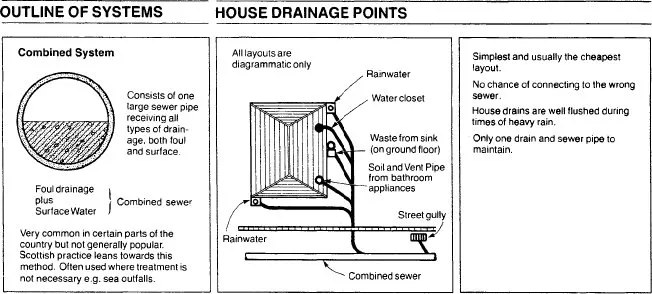

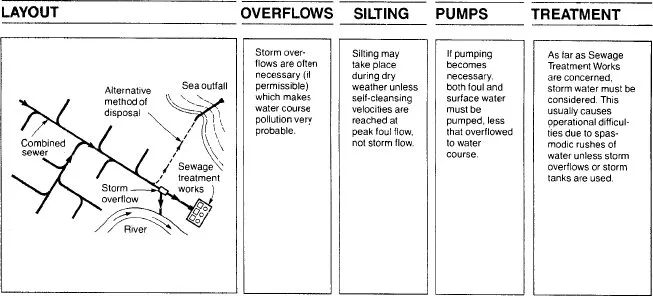
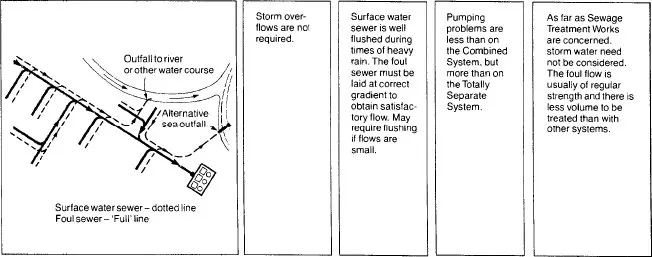
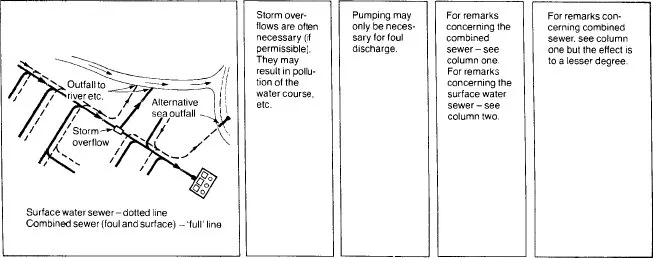
Aim and Design Considerations
CI/SfB(52)
Aim
The aim is to provide a system of self cleansing pipework for -
- the conveyance of foul waste and surface water.
- Speedily and efficiently to the sewer or other outfall,
- Without risk of nuisance or danger to health.
Design Considerations

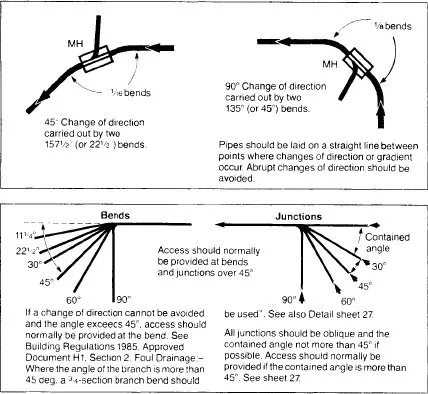

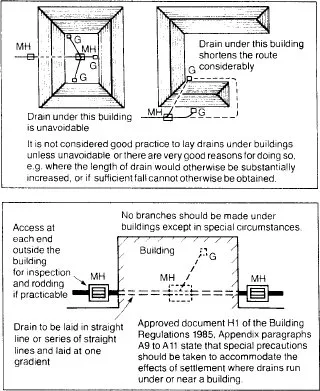
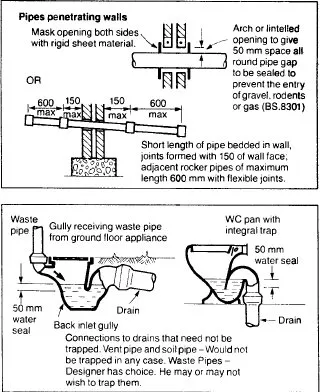
See Approved Document H1, table 2, of the Building Regulations 1985 for minimum trap sizes and seal depths.
Appliance | Diaof Trap mm | Depth of seal mm |
Washbasin, bidet | 32 | 75 |
Sink, bath, I shower, food waste disposal unit, urinal bowl | 40 | 75 |
WC Pan | 75(min) | 50 |
All points of discharge into the system should be fitted with a water seal (trap) to prevent foul air from the system entering into the building underworking.
The distances between access points depend on the types of access used but should not be more than shown in Table 10 of Document H1 of the Building Regulations 1985 for drains up to and including 300 mm.
Definitions
- Surface water. The run-off natural water from ground surface including paved areas, roofs and unpaved lands.
- Waste water. Water not contaminated by soil water or trade effluent can be taken as the discharge from lavatory basins, baths, sinks and similar appliances.
- Soil water. The discharge from a soil appliance such as water closet, urinal receptacle, bed pan washer, slop sink, etc.
- Foul drain. A drain normally designed to take the discharge of both soil and waste water (may also receive trade effluent).
- Waste drain. To receive waste water as distinct from soil and trade effluent.
- Surface water drain. To receive surface water exclusively.
- Inspection chamber. Chamber constructed on a drain so as to provide access thereto for inspection and cleansing (often called "manhole").
Schemes for Town Houses
CI/SfB(52)
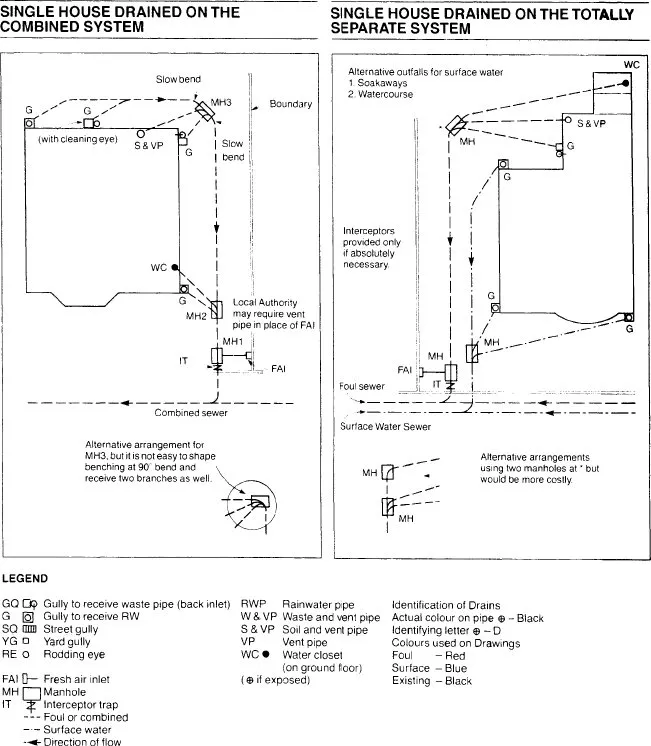
Group of Houses Drained on the Partially Separate System
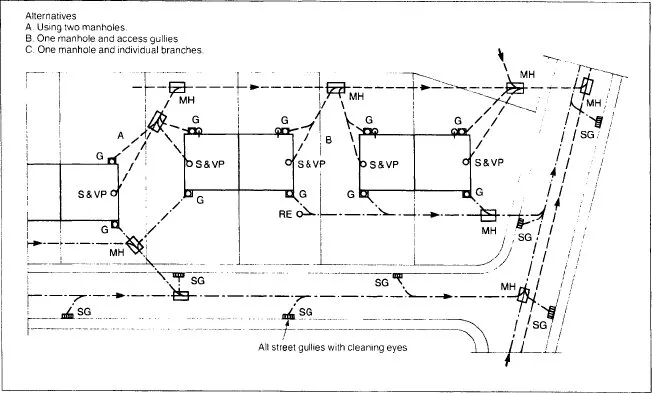
Group of Houses Drained on the Combined System
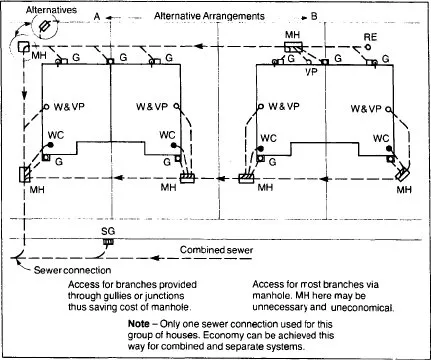
Terraced House

Schemes for Country Houses
CI/SfB(52)
Septic Tanks
In recent years the prefabricated grp septic tanks has tended to supersede the conventional brick or concrete ring units -offering simplicity of installation and cost benefits.
The Septic tank is still a common method of disposing sewage and waste water from single properties and small communities. It provides an environment where gross solids may settle out and where this stored organic matter may undergo anaerobic decomposition. The partially treated liquor then flows to a network of sub-surface irrigation drains to be discharged into the land.
The efficiency of the tank system relies on the suitability of the sub-soil to accept the volume of liquor without causing pollution. Where the sub-soil has a high clay content or similar non-absorbent material, or where there is a high level of ground water, septic tanks will not operate effectively.
Percolation tests will determine the suitability of a particular site for sub-surface irrigation - and details of these tests are set out in BSCP 6297:1983.
Klargester Environmental Engineering makes Septic Tanks in accordance with the Code of Practice, providing a daily flow allowance of at least 180 litres per person on the system, plus a further 2000 litres. Settled sludge is required to be removed from the tank once every year.
Problems experienced with septic tank installations can often be related to the failure to consider either the site ground conditions (soil porosity, high water table) or the requirement for regular de-sludging.
The design feature of the Klargester unit is to prevent gross solids being flushed through the system. This is achieved by means of a series of baffles within the tank creating an upward flow of effiuent through individual stages prior to discharge. Where the ground adjacent to the tank is unsuitable for sub-surface irrigation, a simple pumpset incorporating a prefabricated grp sump may be used to pump the effluent to a remote area where the ground is more suitable.
Care should be taken to instal the tank in accordance with the manufacturer‘s instructions.
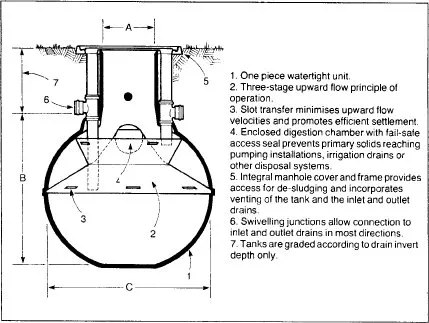

Cesspools
With certain drainage problems, septic tanks may not provide the answer - but the use of a cesspool might. By design, a cesspool is a watertight construction for storing sewage; and difficulties in obtaining a watertight construction for storing sewage have now been generally overcome by using prefabricated glass fibre tanks, which also make installation simpler.
Its physical size can make the installation of a cesspool of the minimum recommended capacity of 18,000 litres a costly business. But, one of the biggest disadvantages could be the recurring emptying costs. An average four-person family could fill the tank in between five and eight we...